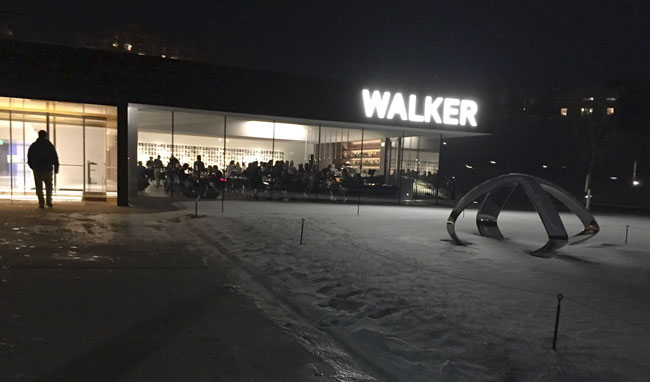
Among the victims of the epidemic of “fine dining” closings is Piccolo, whose chef-owner, Doug Flicker, has shifted his expertise to the Walker Art Center. We were at the Walker’s Esker Grove for lunch and dinner recently and can report that there is much to like, but much that is lacking.
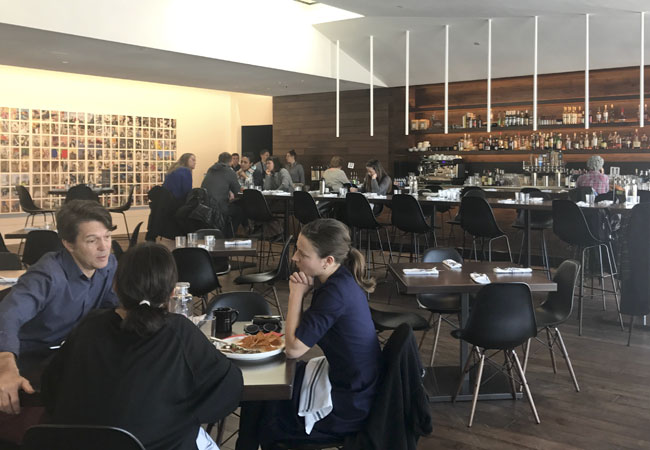
The setting is one of contrasts. Part contemporary cavern: dark wood everywhere, a row of long, of counterlike raised tables, and (very comfortable) black leather Eames chairs. And part pure light, at least by day: The north wall is made of glass and looks out onto the sculpture garden, now mostly snowy white, except for the iconic cherry, but the view promises to provide color and beauty once spring arrives. Additional brightness comes from a skylight. On the back wall is a monumental mural by Frank Big Bear, a collage of newspaper and magazine pages from the past 40 years.

The Walker has had mixed success with its restaurants. We were great fans of Gallery 8, the Walker’s original cafe, which closed in 2003, when the building expansion began. The food was attractive, varied, and every bit as delicious as carefully thought out cafeteria-line food could be. When the museum reopened in 2005, the Gallery 8 space had food that we remember only as being gummy. Meanwhile, in the new wing, Wolfgang Puck’s 20.21 served quite good Asian fusion food. But a high-end restaurant serving dinner as well as lunch somewhere up an elevator inside a museum was destined to fail, and its successor, Gather, went the same route. Now, Esker Grove, in a prominent main-floor location, needs to find a successful blend of creativity, style, and flavor while pleasing a wide range of palates and budgets.
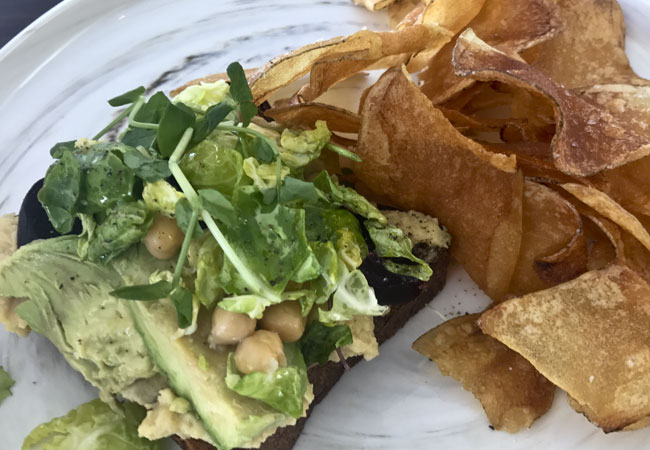
For lunch, we tried the Hummus Toast ($8), an open-faced sandwich. The hummus contrasted freshness — first apparent as a burst of lemon — with a rich earthiness that comes through in the tahini. The tart-earthy mix was echoed in the garnish of blanched Brussels sprout leaves in a bright vinaigrette on one hand, and unadorned red beets, avocado, and a sprinkling of garbanzos on the other. The base was a slab of lightly toasted Pan Brioche from Baker’s Field; it added another acidic element to the dish via its natural yeasts, although no self-respecting classic brioche would so much as hint at sourness. The rest of the plate held a pile of thin, crisp, but oversalted potato chips.

Dessert choices were surprising limited: just a brown sugar cookie, a chocolate cookie, and a muffin. We’ve always felt that “real” museum cafes should have artworthy desserts for visitors to savor while restoring their energy for more gallery walking, and we were rather shocked to see this plain selection in a glass display case. The Brown Sugar Cookie ($2) was quite good, though. It was chewy at the center and had a nice crunch at the edges. The Division Blend coffee ($2.50) from Spyhouse, was fragrant and well-brewed.
The dinner menu proved to be a mixed bag at a price point where it’s a bit dangerous to get anything wrong.
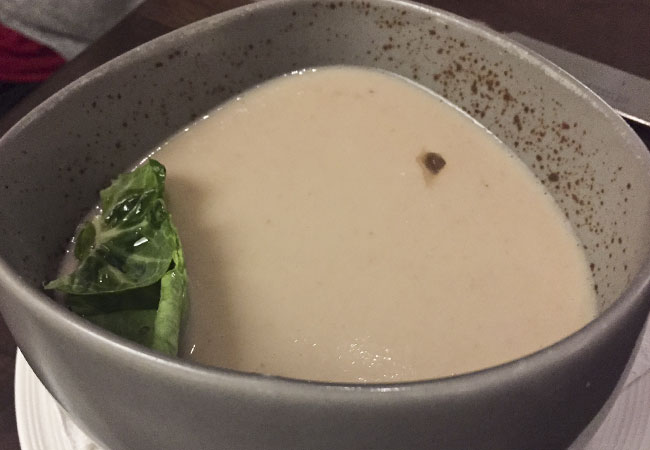
The chestnut soup ($9) was stellar — richly creamy yet light upon the palate, with a compelling, earthy base.

And the Spit Roasted Sturgeon ($26), with harissa, hearts of palm, and caramelized lemon, was one of the loveliest pieces of baked fish we’ve had in recent memory — firm flesh and light but substantial flavor complemented by the surprisingly concentrated lemon juice.

But the Capon ($24) was both dry and surprisingly small. As a $12 appetizer, it would have been a mild disappointment, but as a main course it seemed borderline absurd.
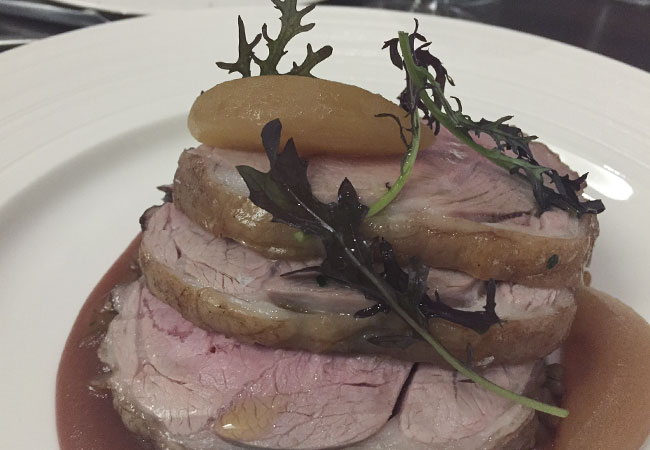
And at $27, the Lamb Shoulder was fatty and unremarkable, although the wheat berries that surrounded it were lovely and perfectly prepared.
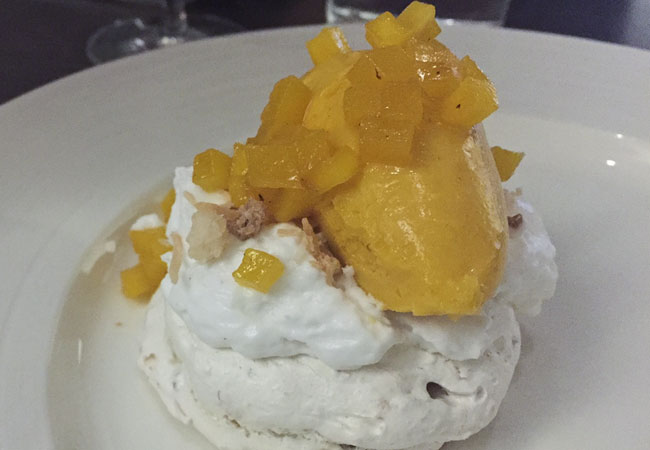
The desserts on the dinner menu, while more substantial than those at lunch, proved to be disappointing. The Pavlova ($9) had a meringue that was crumbly in places and shoe-leather tough in others, and the overly complicated Budino cake would have worked better as a simple pudding. Our exemplary brown sugar cookie beats these failed elaborate confection any day.

The cocktails, listed as traditional or contemporary, are well done. The martini ($9) from the traditional column, made with Plymouth gin, Dolin dry vermouth, Bittercube Orange Bitters, and a slice of lemon, was a triumph of understatement, with all the clean, neat, poise that you’d hope for from a drink of this pedigree.
By day, there is counter service by a somewhat reserved staff, but they know the food. From 2-5 p.m., coffee and the too-limited dessert-case offerings are available. By evening the service is more engaged, a pleasant mixture of friendliness and knowledge. The noise level during lunch, in the sparsely occupied room, was muted. Conversations did not carry, which is pleasant and rare. By night, the room was lively but not particularly loud.
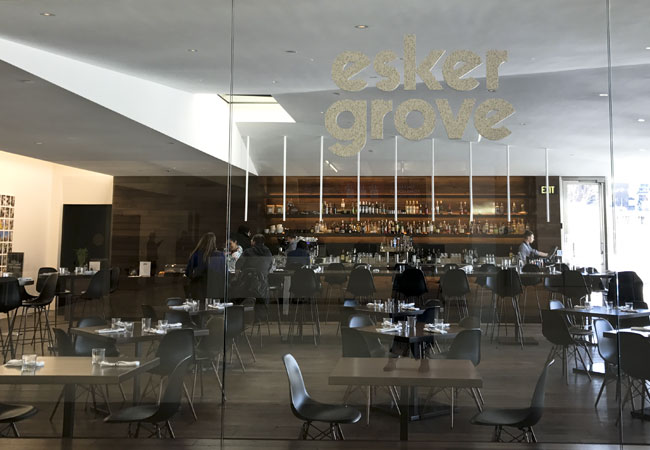
All in all, Esker Grove is a comfortable place to stop for lunch when you’re at the Walker, but at this stage it lacks the range and consistency of its American Swedish Institute rival, Fika. And at dinnertime, with so many excellent alternatives in its price range — Bachelor Farmer and Alma, to name two — Esker Grove has some work to do before it becomes a destination restaurant.
James Norton contributed to this article.
Esker Grove
Cafe dining in the Walker Art Center’s lobby
Rating: 


 (good)
(good)
723 Vineland Place
612.375.7542
OWNER / CHEF: Culinaire / Doug Flicker
HOURS
Lunch:
Tue-Sun, 11 a.m.-2 p.m.
Dinner:
Tue-Sun, 5 p.m.-9 p.m.
Fri-Sat 5 p.m.-10 p.m.
Coffee Service:
Tue-Fri, 9 a.m.-11 a.m.
RESERVATIONS / RECOMMENDED?: Yes for dinner only / Yes
VEGETARIAN / VEGAN: Yes / Yes
ENTREE RANGE: Lunch $8-$14; Dinner $21-$32
NOISE LEVEL: Muted by day; lively but not loud at night
PARKING: Attached paid lot; limited street parking
